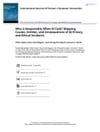⚡ Quick Summary
Published in the International Journal of Human–Computer Interaction (2025), this paper develops a taxonomy of 202 AI privacy and ethics incidents, linked to stages of the AI lifecycle—training, deployment, use, and user interaction. The authors identify incident types, causes (technical, human, organizational, governmental), responsible entities (developers, algorithms, users, deploying organizations, public authorities, data repositories), disclosure sources, and consequences.
Most incidents arise from organizational decisions and legal violations rather than technical failures. Developers and deployers rarely report incidents themselves, and corrective actions are limited.
The authors call for stronger governance measures—mandatory incident reporting, external auditing, better enforcement of standards, and protection mechanisms for children and social media users.
🧩 What’s Covered
- Research Goal and Gap. Existing AI risk taxonomies rely heavily on secondary literature and rarely analyze contextual factors like cause, accountability, and disclosure. This study grounds its framework in empirical data from real incidents.
- Methodology. The authors perform thematic analysis of 202 reports from the AIAAIC repository, using collaborative coding to develop a schema of 13 incident types, 5 causal categories, 7 responsible-entity categories, disclosure modes, and impact outcomes. Both data and codebook are publicly available.
- Lifecycle Taxonomy. Incidents are categorized by lifecycle stage:
- Training: dataset misuse, bias, secondary data use
- Deployment: secondary use of AI features, policy violations
- Use: deepfakes, harassment, deanonymization, security breaches
- Communication: misleading terms of service, disinformation amplification by public figures.Figures 3–4 visualize links between types, causes, and responsible actors.
- Who Is Responsible. The largest share involves developers and their partners (33%) and algorithms (7%)—together forming 38% of all incidents. They are followed by users (25%), deploying organizations (23%), public authorities (6%), and data holders/platforms (~1%). Developers dominate consent, transparency, and compliance failures; users dominate deepfake and harassment cases.
- Primary Causes. Beyond technical errors (hallucinations, mismatches, failures), key causes include lack of consent and transparency, legal non-compliance, unethical business conduct, and regulatory loopholes(e.g., around deepfakes or biometrics). Sometimes incidents stem from intentional government manipulation.
- Disclosure Patterns. Most incidents are exposed by victims, media, or third parties; fewer than 5% come from those closest to the systems (developers, deployers, data platforms). This creates a “blind spot” before public release. Figure 5 (p. 24) visualizes disclosure pathways and responsible entities.
- Consequences. 55% of incidents result in public backlash or reputational harm, 45% lead to direct damage(privacy loss, autonomy violations, reputational/financial/physical harm), yet only 37% trigger legal or organizational remediation. Figure 6 (p. 25) links incident types to outcomes.
- Policy Implications. Regulation alone is insufficient—some companies and government actors actively bypass rules. The authors call for external audits, mandatory incident reporting, and platform-level moderation policies to mitigate emerging harms.
💡 Why It Matters
For AI governance professionals, this study bridges real-world incidents with operational governance controls. It demonstrates that most risks are not algorithmic but organizational—stemming from poor consent practices, opaque data reuse, and weak ethical oversight.
It empirically supports several governance priorities under the EU AI Act and NIST AI RMF:
- Mandatory incident reporting and minimum transparency standards
- External auditing and ex-ante/ex-post impact testing for high-risk systems
- Platform accountability for deepfakes, manipulation, and harassment
- Protection of minors and vulnerable groups as a compliance priority.This dataset serves as a ready-made foundation for risk registers, incident playbooks, and ethics-by-design frameworks.
❓ What’s Missing
- Dependence on public reporting. The dataset excludes unreported or internal incidents, leaving gaps in early-stage failures.
- Possible label bias. The focus on “privacy/ethics” tags in AIAAIC may have missed adjacent categories (security, fairness).
- Unvalidated interventions. The policy recommendations are strong but not field-tested; further empirical validation is needed.
- Limited sectoral and geographic breakdown. The analysis does not differentiate clearly between jurisdictions or industries, reducing direct regulatory mapping.
👥 Best For
- AI compliance and risk leaders – to integrate taxonomy into risk registers and KRI dashboards.
- Trust & Safety / platform teams – for moderation policy design and misuse detection.
- Regulators and policymakers – to support arguments for mandatory reporting and AI audits.
- Academic and governance researchers – as an empirical base for cross-sector incident analysis.
📄 Source Details
Hilda Hadan, Reza Hadi Mogavi, Leah Zhang-Kennedy, Lennart E. Nacke. International Journal of Human–Computer Interaction, published online 15 Sep 2025.
The paper identifies four main contributions, based on 202 AIAAIC incidents (2023–2024), with open data, codebook, and visual mappings of causes, responsibilities, and consequences.
📝 Thanks to
The authors and the AIAAIC research collective for maintaining the open incident database, and IJHCI reviewers for enhancing methodological rigor.
AIGL Reader Notes
- Most common incident type: Non-consensual imagery and impersonation (deepfakes) – see Figure 6.
- Largest responsible group: Developers (33%), mainly in consent and transparency violations.
- Systemic gap: <5% of disclosures originate from insiders—pointing to the need for mandatory incident reporting and external auditing (Figure 5).
Figures 3–4 offer detailed heatmaps linking types, causes, and responsible entities—ideal for embedding into enterprise risk controls and AI assurance frameworks.


